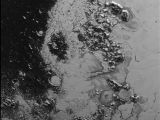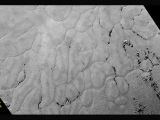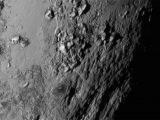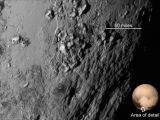A new view of Pluto shows a mountain range towering over the orb's surface in the southwestern edge of the heart-shaped Tombaugh Region. The mountain range separates an odd landscape made up of icy planes from a nearby cratered terrain.
The peaks were spotted by NASA's New Horizons spacecraft on July 14, the day of its historic flyby of dwarf planet Pluto. As it was racing towards its target orb, the probe used its Long Range Reconnaissance Imager to snap a photo of the mountain range from a distance of 48,000 miles (77,000 kilometers).
NASA scientists estimate that the newly discovered peaks measure about 0.5 to 1 mile (1 to 1.5 kilometers) in height, which means that they are about as tall as the Appalachian Mountains in North America.
Another alien mountain range lies nearby
These frozen mountains that the New Horizons probe discovered nestled between Pluto's icy plains and neighboring cratered terrain in the Tombaugh Region are not the first peaks that the spacecraft discovered on this alien world.
One other mountain range, dubbed Norgay Montes, lies in the dwarf planet's equatorial region and towers over the local landscape at a height of about 2.2 miles (3.5 kilometers). This other mountain range is estimated to have formed around 100 million years ago.
Although it is still unclear whether they came into being around the same time in Pluto's history or even as a result of the same geological processes, what's obvious is that the newly identified mountain range and the dwarf planet's Norgay Montes are oddly close neighbors.
Thus, researchers estimate that these two mountain ranges that the New Horizons probe has so far revealed on the surface of Pluto lie at a distance of merely 68 miles (110 kilometers) from one another.
Pluto is an odd place, there's no denying it
Not that all the other celestial bodies in our Solar System are perfectly ordinary - gas giant Jupiter, for instance, is quite a sight - but as it turns out, Pluto has its quirks too.
For instance, scientists are yet to figure out why it is that, despite being close neighbors, Pluto's icy plains and cratered terrain in the Tombaugh Region look so different from one another.
“There is a pronounced difference in texture between the younger, frozen plains to the east and the dark, heavily-cratered terrain to the west. There’s a complex interaction going on between the bright and the dark materials that we’re still trying to understand,” said researcher Jeff Moore.
One possible explanation is that, whereas the plains formed at a later time in the dwarf planet's history, the nearby darker terrain that is riddled with craters is billions of years old.
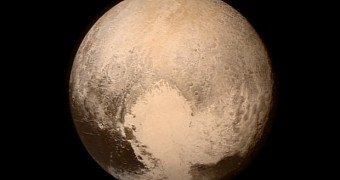
 14 DAY TRIAL //
14 DAY TRIAL // 
